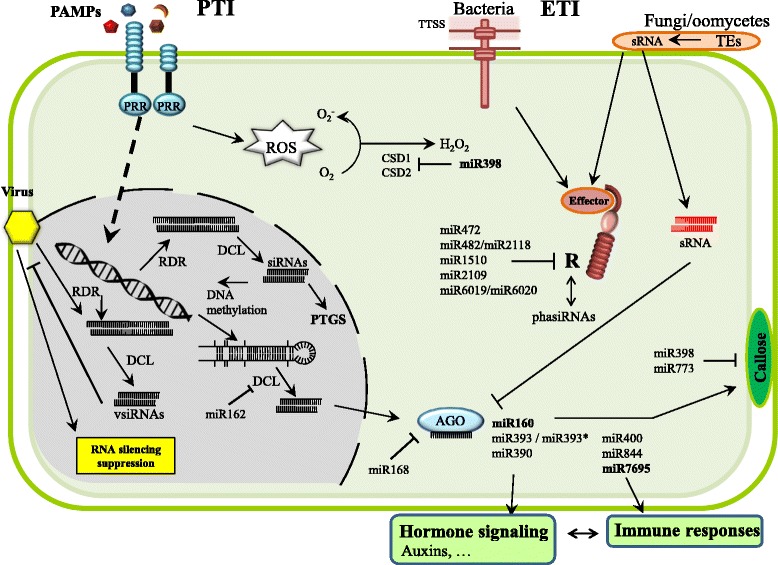Fig. 1.

Functionally characterized miRNAs in relation to disease resistance. Most of the indicated miRNAs have been characterized in Arabidopsis plants infected with Pseudomonas syringae. Dicer-like proteins (DCLs) process double-stranded RNAs or single-stranded RNAs with hairpin structures, giving rise to mature sRNAs which are loaded into Argonaute (AGO)-containing RNA induced silencing complexes (RISCs) to induce gene silencing of their complementary targets. The RNA silencing-based antiviral defence involves the production of virus-derived sRNAs (vsiRNAs) by DCL activities that drive degradation of viral RNA in a sequence-specific manner. In addition to post-transcriptional gene silencing (PTGS)-based regulation, a role for RNA-directed DNA methylation (RdDM) in plant disease has emerged. Two miRNAs, miR162 and miR168, are involved in the regulation of the miRNA pathway itself by guiding cleavage of DCL1 and AGO1 mRNAs, respectively. In rice, the involvement of miR160, miR398 and miR7695 (in bold) in PTI responses is documented (Campo et al. 2013; Li et al. 2013). miR160 targets Auxin Response Factors (ARFs) whereas miR398 targets Cu/Zn superoxide dismutase genes. MiR7695 targets an alternatively spliced transcript of the Natural resistance-associated macrophage protein 6 (Nramp6) gene from rice. In the case of miR393, the two sRNAs of the duplex are functional during pathogen infection (miR393 targets TIR1, whereas miR393* regulates MEM12, a Golgi-localised SNARE protein that modulates exocytosis of antimicrobial PR1 proteins in Arabidopsis (Zhang et al. 2011). ETI, Effector-Triggered Immunity; PAMPs, Pathogen-associated molecular pattern; PRR, Pattern recognition receptor; PTI, PAMP-Triggered Immunity; TTSS, Type three secretion system; RDR, RNA-dependent RNA polymerase; sRNA, small RNA; TEs, Transposable elements; ROS, Reactive oxygen species; CDS, Copper/Zinc superoxide dismutase
